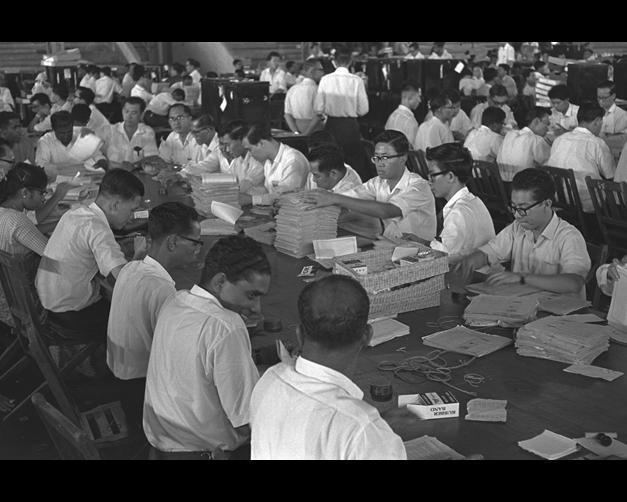 | ||
A referendum on the terms of integration into formation of Malaysia was held in Singapore on 1 September 1962 to adopt United Nations General Assembly Resolution 1514 (XV) under titled Declaration on the Granting of Independence to Colonial Countries and Peoples provided for the granting of independence to colonial countries and peoples in providing an inevitable legal linkage between self-determination and its goal of decolonisation, and a postulated new international law-based right of freedom also in economic self-determination. In Article 5 states: Immediate steps shall be taken in Trust and Non-Self-Governing Territories, or all other territories which have not yet attained independence, to transfer all powers to the peoples of those territories, without any conditions or reservations, in accordance with their freely expressed will and desire, moreover on 15 December 1960 the United Nations General Assembly re-adopted United Nations General Assembly Resolution 1541 (XV) under titled Principles which should guide members in determining whether or nor an obligation exists to transmit the information called for under Article 73e of the United Nations Charter requires countries administering those colonies to develop self-government, to take due account of the political aspirations of the peoples, and to assist them in the progressive development of their free political institutions.
Contents
Voters were offered three options, but did not have the choice of opposing integration. Option A, which provided for the highest level of autonomy was chosen by 96% of voters.
Background
The first internal challenge to merger with the Federation of Malaya came from and grew out of a political struggle between the People's Action Party (PAP) and their opponents included the Barisan Sosialis (Socialist Front), the Liberal-Socialist Party, the Workers’ Party, the United People’s Party and the Partai Rakyat (People’s Party).
In Singapore, the PAP sought formation of Malaysia on the basis of the strong mandate it obtained during the general elections of 1959 when PAP won 43 of the 51 seats. However, this mandate became questionable when dissension within the party led to a split. In July 1961, following a debate on a vote of confidence in the government, 13 PAP Assemblymen were expelled from the PAP for abstaining to form a new political party, the Barisan Sosialis or the Barisan have consequences the PAP's majority in the Legislative Assembly was whittled down as they now only commanded 26 of the 51 seats.
The ruling PAP was not legally obliged to call for a referendum, but did so to secure the mandate of the people. However, the Barisan Sosialis, a left-wing socialist party consisting of former PAP members with communist sympathies pedigree to the opposition to the colonialism, and imperialism movements were alleged that the people did not support merger, but Lee Kuan Yew declared that people did.
The referendum did not have an option of objecting to the idea of merger because no one had legitimately raised the issue in the Legislative Assembly before then. However, the methods had been debatable. The referendum was therefore called to resolve the issue as an effort to decide objectively which option the people backed. The legitimacy of the referendum was often challenged by Singaporean left-wingers, due to the lack of an option to vote against the merger.
Council of Joint Action
The Council of Joint Action (CJA) founded by 19 members of the Assembly to block the merger and scuttle the referendum by taking the issue before the UN Committee on Colonialism. On 6 July 1962, The CJA signed a memorandum condemning the referendum on the grounds that the proposed constitutional changes and to assure its continued right to bases in Singapore, and to protect its privileged economic position. The CJA also criticized the terms, and the lack of choice in the referendum. In the memorandum, The CJA concluded that the transfer of sovereignty would be contrary to the spirit and resolution of the United Nations General Assembly’s Declaration on the Granting of Independence to Colonial Countries and Peoples.
Campaign
Being strongly against the referendum, the Barisan Sosialis called for a boycott of the referendum, telling supporters to submit blank votes in protest of the "rigged" referendum. Over 144,000 blank votes were cast, over a quarter of all votes. This move had been anticipated by the ruling PAP government, as seen by the insertion of a clause that stated that all blank would be counted as a vote for the option that wins the most votes if there was no outright majority or that blank votes would be counted as Option A.
The media campaign fielded by both sides was extremely heated, many of the leaders on both sides broadcast radio shows in several languages.
Aftermath
Backed by the official mandate, the Agreement relating to Malaysia between the United Kingdom of Great Britain and Northern Ireland, Federation of Malaya, North Borneo, Sarawak and Singapore was signed on 9 July 1963.
Singapore entered into merger with Malaya on 16 September 1963, marking the birth of Malaysia. Singapore ceased to be a state of Malaysia on 9 August 1965 when it became an independent state.
